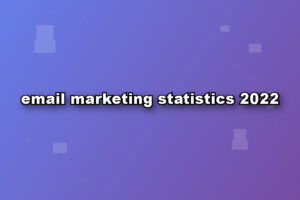Email marketing remained a powerful tool in 2022. Businesses used it to talk to customers. People checked their emails a lot. This made email a very important way to share messages. It was not old-fashioned at all. In fact, email kept growing stronger. Many studies showed its continued success.
Think about how many emails you get daily. In 2022, billions of emails were sent. This huge number proves email’s reach. Companies focused on sending good messages. They knew that clear and helpful emails truly made a difference. This strategy helped them connect well with their audience. Therefore, email marketing continued to be a top choice.
The Big Picture: Usage and Growth
In 2022, there were over 4.258 billion active email users globally. This number kept increasing. Experts predicted even more users in the future. Over 3.13 million emails were sent every second. This shows how busy email channels were. People had many email accounts too. On average, a person had almost two email accounts.
Many users checked their email daily. Some even checked it 20 times a day. For many, email was the first thing they looked at online. It was more popular than social media or news sites. This strong habit highlights email’s importance. Most people over 15 in the US used email. These facts clearly show email’s wide reach.
Image 1: A visual representation of global email users and daily email volume in 2022.
(Imagine a simple, clean infographic. On the left, a large number like “4.25+ Billion Email Users” with a small person icon. On the right, a spinning globe with email icons flying off, and a text bubble saying “333 Billion Emails Sent Daily”. Below both, a timeline showing growth from 2021 to 2023 with upward arrows.)
How Emails Made Money
Email marketing showed a great return on investment (ROI). For every dollar spent, businesses got a lot back. Some companies even saw an ROI greater than $70 for every $1 invested. This high return made email very attractive. It often made more money than other marketing ways. Email campaigns directly led to sales.
Many consumers bought things after getting marketing emails. Over 50% bought something at least once a month. Some even bought several times a month. This shows how effective emails were at driving purchases. Therefore, businesses invested more in their email efforts. They saw clear profits from their campaigns.
Key Performance Indicators: What Worked Best
Email marketing success could be measured in many ways. Open rates, click-through rates, and conversion rates were important. These numbers helped businesses understand how well their emails were doing. Keeping an eye on these metrics was crucial. It helped them make better plans for the future.
Furthermore, email content played a big role. Engaging subject lines encouraged opens. Clear calls to action led to clicks. Relevant content then drove conversions. Marketers constantly worked to improve these elements. They used data to guide their decisions. This made their email campaigns more effective over time.
Opening Up: Email Open Rates
In 2022, the average email open rate was about 19.66% to 21.5%. This means almost one-fifth of people opened the emails they received. However, this number varied by industry. For example, education and agriculture industries had higher open rates. They averaged between 25% to 28%. This often happened because schools and farms needed to share important updates.
Subject lines were very important for open rates. Nearly half of people opened an email based on its subject line alone. Short, clear subject lines worked well. Adding emojis could slightly increase open rates too. Personalizing the subject line with the recipient’s name also helped. It made people more likely to open the email.
Getting Clicks: Click-Through Rates
After opening an email, people might click on a link inside. This is called the click-through rate (CTR). In 2022, the average CTR was around 2.3% to 2.6%. This percentage also changed based on the industry. Some industries, like real estate and education, saw higher CTRs. Their rates could go up to 3% or even 4.4%.
To get more clicks, emails needed clear calls to action (CTAs). These are buttons or links that tell people what to do next. Using engaging visuals also helped. Pictures and GIFs made emails more interesting. A/B testing different designs helped find what worked best. This process improved click rates over time.
Image 2: A chart showing average email open and click-through rates by industry in 2022.
(Imagine a bar chart or a pie chart. It has different colored segments for various industries like “Education,” “Retail,” “Financial Services,” etc. For each industry, there are two bars/sections: one for “Average Open Rate %” and another for “Average Click-Through Rate %”. Make sure the percentages are distinct and easy to read, reflecting the ranges mentioned in the text.)
Making Sales: Conversion Rates
The goal of many marketing emails is to get a conversion. This means someone takes a desired action. It could be buying something, signing up, or downloading a file. In 2022, the average email conversion rate was often between 2% and 5%. However, specific types of emails performed much better.
Abandoned cart emails had very high conversion rates. They could reach almost 55%. These emails reminded people about items they left in their online shopping carts. Welcome emails also had excellent open and conversion rates. They were sent when someone first joined an email list. These automated emails proved very powerful for converting interest into action.
Smart Strategies for Email Success
Businesses used clever strategies to make their emails work harder. They did not just send out general messages. Instead, they made emails personal. They also used special db to data tools to send emails at the right time. These smart ways helped them get even better results from email marketing.
Furthermore, they thought about how emails looked on different devices. Many people checked emails on their phones. So, emails had to look good on small screens. Keeping up with these practices was key. It helped companies stay ahead.

Personal Touch: Tailored Emails
Personalization meant making emails unique for each person. This could be as simple as using their name. However, it also meant sending content they would truly care about. Emails that were personalized were much more likely to work. They could drive conversions up to six times higher.
Many companies segmented their email lists. This meant dividing people into smaller groups. These groups had similar interests or behaviors. Then, tailored emails were sent to each group. For example, customers who bought certain products would get emails about similar items. This made emails more relevant and effective.
Automated Emails: Working Smarter, Not Harder
Email automation was a big trend in 2022. This meant setting up emails to send automatically. For instance, a welcome email would go out when someone subscribed. An abandoned connecting with your hr community cart email would send if a user left items in their cart. These automated emails saved time and generated great results.
Automated emails had much higher open and click-through rates. They also led to more revenue. Welcome series emails, for example, had about a 50% open mobile lead rate. Post-purchase follow-up emails also performed very well. Businesses that used automation saw better overall marketing performance. It truly helped them grow their sales.
